
Manufacturer's Specifications:
Frequency Response: 5 Hz to 20 kHz, ±0.3 dB.
Dynamic Range: Greater than 90 dB.
S/N: Greater than 90 dB.
Harmonic Distortion: Less than 0.004% at 1 kHz.
Channel Separation: Greater than 90 dB at 1 kHz.
Output Voltage Level: Fixed, 2.0 V; variable, 0 to 5.0 V.
Number of Searchable Selections: Up to 99 for both track and index numbers.
Access Time: One second (average).
Power Requirements: 120 V, 50/ 60 Hz, 55 watts.
Dimensions: 16.54 in. (42 cm) W x 5.3 in. (13.5 cm) H x 13.4 in. (34 cm) D.
Weight: 21.56 lbs. (9.8 kg).
Price: $1,000.00.
Company Address: 82 Totowa Rd., Wayne, N.J. 07470.
If fast random access to selections on a Compact Disc is what you're after, the Toshiba XR-Z90 CD player is for you. I have never worked with any CD player that could find a given spot on a Compact Disc more rapidly. And if any record producer should ever decide to set a new record (no pun intended) for the greatest number of selections on CD, the Toshiba player will be able to find any of 99 such "tracks." The rapid access achieved by this player is attributed by Toshiba to what they have dubbed a "one-beam time-difference detection system." Up to eight selections may be programmed in the unit's memory, and that many tracks can be played back in any sequence you choose. A repeat function allows you to play an entire disc over again or to repeat-play memorized selections, all at the press of a single button. Player operations are controlled by light-touch pushbuttons, and discs are loaded vertically into a disc compartment, via a door that opens out like the doors on front-loading cassette decks.
While I had very little information on hand regarding the circuitry in the player, I did learn that it employs an 11th order low-pass filter, with its cutoff frequency tuned to 20 kHz, to eliminate any noise above that frequency generated by the D/A conversion process. Following D/A conversion, the analog audio output stages use Lambda capacitors and copper-foil Styrol capacitors in a low-impedance output circuit that does not degrade the sound quality.
Control Layout
Just to the left of the disc compartment are an eject button (which opens the disc compartment) and the power on/off button. The major disc transport and play buttons at the upper right of the front panel are "Rev," "FF," "Play," "Pause" and "Stop." The "Next Play" and "Repeat" buttons are located just below a multi-function display area to the right of the disc compartment.
The display area provides a veritable wealth of information to the user. At the left are three word displays ("Eject," "Search" and "Error") which illuminate at the appropriate times. Large numerals in the center of the display area show the track number being played, plus the elapsed time in minutes and seconds for that particular track. Adjacent to the track numbers are smaller numerals which display the "index" number within a given selection. Some discs, especially those containing long classical selections such as movements of a symphony, may subdivide such selections into "index" numbered subsections, and these may be accessed using this track-plus-index number scheme.
Words to the right of the track and time display illuminate to denote "Repeat," "Manual," "Auto" and "Memory," as these functions are called into play. Small rectangles below the track and time digits, numbered from 1 to 8, glow or flash to show which track number is being stored in which numbered memory or, during playback, which numbered memory selection is then being played.
Because the operating buttons of this unit are of the ultra light-touch variety, it isn't always easy to tell whether you have actually depressed a button enough to cause the appropriate action to take place. Accordingly, Toshiba has incorporated a little "chirp" sound which is heard whenever you touch any of the many buttons just described. A switch on the rear allows you to deactivate the chirp if you wish.
Two sets of output jacks are also found on the rear panel.
The first pair provides fixed output levels of left and right channels, while the second pair provides variable output, controlled by an adjacent output level control.
Measurements
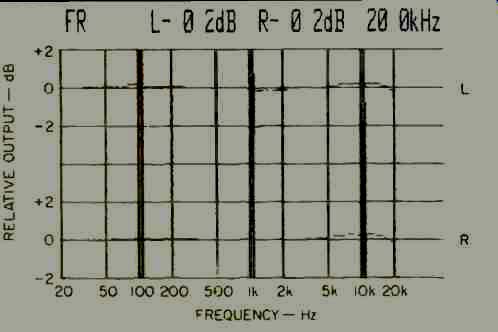
Fig. 1-Frequency response, left (top) and right channels at 0 dB (maximum) level.

Fig. 2--Harmonic distortion vs. frequency at levels of 0 dB (bottom curve),
-24 dB (middle curve), and -30 dB (upper curve).
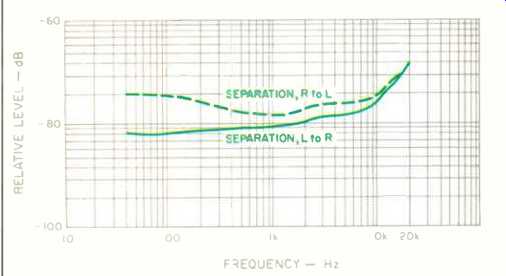
Fig. 3--Channel separation vs. frequency.
Figure 1 is a plot of frequency response for the left and right channels of the player, using the Philips test disc sweep signals which extend from 20 Hz to 20 kHz. Frequency response was extremely uniform on this player, varying by only ±0.2 dB up to the 20-kHz test point. Harmonic distortion at mid-frequencies for maximum recording level was exactly 0.004%, as specified by Toshiba, rising somewhat at the high-frequency end as shown in the graphs of Fig. 2. Also plotted in Fig. 2 are curves of harmonic distortion versus frequency for lower test signal levels of -24 and -30 dB. As you would expect for any digital system of this kind, distortion al lower levels rises, but even at the -30 dB level, THD was well below 0.1%.
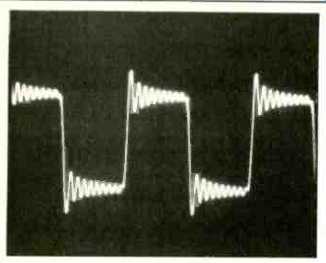
Fig. 4--Reproduction of 1-kHz square wave.
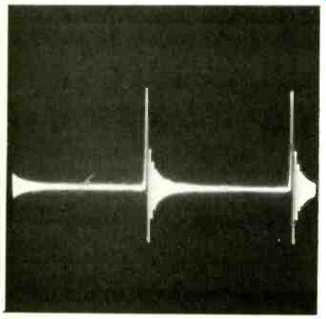
Fig. 5--Pulse test.
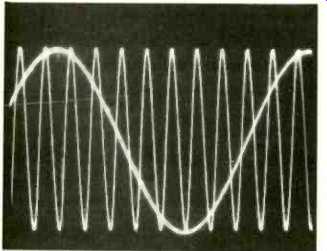
Fig. 6--Phase-linearity test, 2and 20-kHz signals.
Stereo separation hovered well above the 70 dB mark for all of the test frequencies. A graph of stereo separation versus frequency is reproduced in Fig. 3. Output linearity was extremely accurate from maximum levels all the way down to-80 dB. Intermodulation distortion measured 0.0033% at maximum recorded level output, increasing slightly to 0.006% at a-20 dB recorded level. Signal-to-noise ratio measured a very high 95 dB, without any weighting network, increasing to nearly 100 dB when an A-weighting compensation curve was introduced.
Figure 4 is a 'scope photo of a 1-kHz square wave as reproduced by the Toshiba player from the appropriate band on the Philips test disc. The apparent high-frequency "ringing" is typical of that which I have seen on all CD players that employ post-D/A, sharp-cutoff, low-pass filters.
The same holds true for the single-pulse signal reproduced by the XR-Z90, shown in Fig. 5.
The phase-check signal, consisting of a 2-kHz sine wave on one channel and a 20-kHz tone on the other, was used to ascertain phase delay. Phase error between mid- and high frequencies caused by the multi-pole, sharp-cutoff filter seemed a bit lower than usual, as can be seen in the 'scope photo of Fig. 6. In a system with no phase error, the low frequency signal's positive crossing of the zero axis is supposed to coincide with the high-frequency signal's positive crossing of the zero axis. In the Toshiba player, an error of about 25° (for the higher frequency, 20-kHz signal) seems to be present. This corresponds to a time-delay error of approximately 3.5 µS. In connection with all three of these tests, Clyde E. Wade, Jr., a reader from Little Rock, Arkansas, has written to me asking whether the Philips test disc that I have been using was made with or without anti-aliasing filters in the recording channels. He points out that if anti-aliasing filters were not used, "then some of the tests that you have conducted were not really valid. Real audio encounters both sets of filters. It is not only CD players that are under test, but the whole digital recording and playback system." To answer Mr. Wade (and also to clear up some lingering misconceptions concerning the Philips test disc), let me state, again, that all of the signals on this disc are computer generated (with the exception of the pink-noise band, which I do not use). That is to say, they are generated from the start as a series of binary number signals, rather than as waveforms which are then sampled and converted to digital format by an A/D converter. Accordingly, no anti-aliasing filters are involved in the creation of this test disc. Mr. Wade's second point is valid, in that indeed, in the real world of audio, signals would not have been encoded onto a Compact Disc in this manner. However, as the title of this test report suggests, I am testing only the CD player.
Since the digital tape masters used to make a CD master may have been created using any one of a number of professional digital recording techniques (some not even operating at the CD sampling frequency), there is no "standard" way to interpose what happens at the recording end.
Each studio's output may introduce varying degrees of phase error, time delay, etc. My purpose has been, and must remain, evaluation of the performance of the player, since I fully expect that future discs may well solve some of the problems now being noticed by some listeners with today's CDs.
Getting back to the subject at hand, I next used my error correction test disc to see what levels of defects in a CD the Toshiba player could handle without audible problems. Error-correction capabilities were not as good as those found on some other machines. With the wedge which simulates scratches in a disc, some sound muting was heard when the width of the wedge reached 600 microns; however, the error-correction circuitry worked very well when tracking black dots on the test disc, which simulate specks of dust.
In that instance, even the widest dots (900 microns) caused no noticeable interruption in reproduced sound. The laser was able to "read" and play right through the fingerprint smudge simulation on the test disc as well.
Use and Listening Tests
The Toshiba XR-Z90 CD player is extremely easy to use and to program for automatic memory play. In terms of suggested retail price ($1,000.00), it offers outstanding performance and a surprising number of convenience features found in more expensive players. Reproduced sound is, as you might expect, beyond reproach.
I particularly appreciated the variable output jacks which are controlled from the back panel. Many CD players without level controls tend to deliver rather large output levels.
While these are usually not high enough to cause first-stage problems in most amplifiers, they do make it necessary to operate amplifier volume controls very near their counterclockwise settings, where fine control of volume levels is difficult. By adjusting the level control on the Toshiba player so that the output levels from the unit more nearly approximated those from other hi-fi program sources (such as my tuner or tape deck), I was able to keep the volume control at or near its more desirable mid-setting. This not only gave me better control of overall volume levels, but helped to avoid the extra-loud levels that I would encounter when switching to CD if I forgot to turn down the master volume control on my reference amplifier before switching. A minor point perhaps, but an important one in the day-to-day use of a CD player.
Further evidence of the high quality built into the XR-Z90 is the fact that Toshiba is a prime manufacturer of its own player (many companies are simply buying the players from other prime manufacturers) and is supplying versions of their machine to other highly regarded companies to sell with their own names affixed to them. Targeted to sell at just about the same retail price as most other players I have been testing of late, the Toshiba XR-Z90 is a very worthy example of how a well-designed CD player should look and work.
-Leonard Feldman
(Source: Audio magazine, Dec. 1983)
Also see:
Toshiba XR-V22 Compact Disc Player (Equip. Profile, Apr. 1986. CD)
Phase Linear 9500 Compact Disc Player (Equip. Profile, June 1983)
NEC CD-803E Compact Disc Player (Nov. 1983)
Technics SL-P8 Compact Disc Player (April 1984)
= = = =